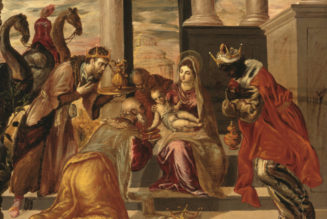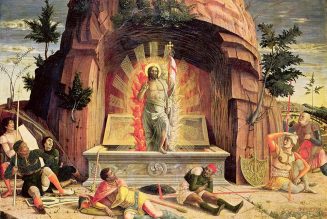While no one collection will be able to cover all the aspects of a giant thinker, “A Guide to John Henry Newman: His Life and Thought” does provide a very good one-stop shopping collection for those who are interested in Newman’s thought and would like something to help them think through what they are reading.
A Guide to John Henry Newman: His Life and Thought, Edited by Juan R. Vélez (525 pages, Catholic University of America Press, 2023)
 Of the making of anthologies there is no end. Some are collections of great essays from the past, some collections of papers from conferences or perhaps solicited pieces in honor of a living or recently deceased scholar and centered around a general theme, while some are meant to be capacious treatments of the different aspects of a particular question or the thought of a particular writer. A Guide to John Henry Newman: His Life and Thought is in the last category. Similar to the Cambridge Companion to John Henry Newman and Oxford Handbook of John Henry Newman, both done in the last 15 years, it is perhaps more like the former insofar as many of the chapters are less in the “scientific” mold of historiographic scholarship and more in the mode of very good introductory chapters to Newman’s thought. Like the latter, however, it is a doorstop volume that aims more at being comprehensive, though not entirely so—there are no chapters on Newman’s fiction, for instance.
Of the making of anthologies there is no end. Some are collections of great essays from the past, some collections of papers from conferences or perhaps solicited pieces in honor of a living or recently deceased scholar and centered around a general theme, while some are meant to be capacious treatments of the different aspects of a particular question or the thought of a particular writer. A Guide to John Henry Newman: His Life and Thought is in the last category. Similar to the Cambridge Companion to John Henry Newman and Oxford Handbook of John Henry Newman, both done in the last 15 years, it is perhaps more like the former insofar as many of the chapters are less in the “scientific” mold of historiographic scholarship and more in the mode of very good introductory chapters to Newman’s thought. Like the latter, however, it is a doorstop volume that aims more at being comprehensive, though not entirely so—there are no chapters on Newman’s fiction, for instance.
The reader considering the volume will first note how many notable scholars and writers from the U.S., Spain, France, Britain, Australia, and Macao contributed. Many are well-known in the world of Newman scholarship, including Paul Shrimpton, John Crosby, Fr. Keith Beaumont, Msgr. Roderick Strange, the late Fr. John T. Ford, David P. Delio, and the editor, Juan R. Vélez. Many others are well-known or talented scholars in their own fields of theology (Michael Dauphinais, Tracey Rowland, Fr. Uwe Michael Lang, Jeffrey Morrow), philosophy (Michael Pakaluk), classics (Scott Goins and Barbara Wyman), and literature (Victor Garcia Ruiz). Not a few are clerics primarily in pastoral work but also scholars (Archbishop Anthony Fisher of Australia, Daniel Seward of the Oratory in York, England, and Fr. Fredéric Libaud of Strasbourg, France).
Of course, it is possible that even distinguished authors can phone in their work, but this is not the case with A Guide to John Henry Newman. All the chapters provide good introductions to the main writings of Newman on a particular subject. Some provide more secondary resources, but they do not necessarily do a better job than those who focus their attention on the primary ones. While no one collection will be able to cover all the aspects of a giant thinker such as Newman, this one does provide a very good one-stop shopping collection for those who are interested in Newman’s thought and would like something to help them think through what they are reading. Anyone who teaches a course on Newman at the undergraduate or graduate level (as I do) will want to either use this book as a secondary text or point students to it for extra reading.
Given the twenty-seven chapters in the volume, a review of this size cannot cover all or even most. So, a few highlights. First, the best summary/synthesis chapters. Ruiz’s Chapter 5 on Newman’s friends gives a kind of tour through some of Newman’s most important friendships. It is charming and could be helpful to people beginning to get to know Newman. Stephen Morgan gives as clear an account of Newman’s understanding of imagination as I have seen in Chapter 3. Fr. Lang’s Chapter 7 on Newman’s use of the Church Fathers, Fr. Libaud’s Chapter 16 on Newman as spiritual master, Fr. Beaumont’s Chapter 18 on the spirituality of his preaching, and Fr. Nicolas Gregoris’s Chapter 25 on his mariological understanding all give brilliant introductions to his spiritual vision and teaching.
Second, some good chapters with an argumentative turn. Chapter 1, by Delio and Matthew Briel, gives a good account of how Newman thought and thought again about the Oxford Movement and the place in which it stood as part of what Newman called the Christian “idea.” It rebuts some of the work of the late Yale historian Frank Turner and his followers who have approached Newman’s account of his own thought with a deep suspicion. On a related topic, Chapter 10 (Christopher Lane) effectively shows how Newman thought of the importance but also the limitations of history. And Jeffrey Morrow’s Chapter 7 gives a good sense of Newman’s often misunderstood thoughts on several aspects of questions of biblical inspiration and interpretation. Archbishop Fisher’s Chapter 19 shows why Newman’s explanation of conscience is so very important to understand correctly in a time in which truth has been sidelined or relativized. Chapter 26 argues that Newman’s understanding of the place of the laity was a forerunner of the ideas of Vatican II and also of theologians (Congar) and saints (Escriva). Chapter 27 (Delio) shows how Newman thought about “liberalism”—both why he used the term the way he did and why his analysis of that phenomenon was essentially correct.
In the end, this volume has something for everybody who’s interested in Newman. If it does not cover everything about Newman, it introduces the reader who knows a little bit and helps the scholar who wants to go deeper or have a way of showing Newman’s thought in a snapshot. As a scholar of Newman, I certainly learned a great deal from excellent chapters on Newman’s educational practice, use of classics, poetry, and liturgical thought. Sympathetic, serious, and scholarly, it is ideal for students, scholars, and lovers of a great saint and mind.
Republished with gracious permission from Gilbert Magazine.
The Imaginative Conservative applies the principle of appreciation to the discussion of culture and politics—we approach dialogue with magnanimity rather than with mere civility. Will you help us remain a refreshing oasis in the increasingly contentious arena of modern discourse? Please consider donating now.
The featured image is “Cardinal John Henry Newman” by Rebecca Dulcibella Orpen, and is in the public domain, courtesy of Wikimedia Commons.
Share This Story, Choose Your Platform!
body{–wp–preset–color–black: #000000;–wp–preset–color–cyan-bluish-gray: #abb8c3;–wp–preset–color–white: #ffffff;–wp–preset–color–pale-pink: #f78da7;–wp–preset–color–vivid-red: #cf2e2e;–wp–preset–color–luminous-vivid-orange: #ff6900;–wp–preset–color–luminous-vivid-amber: #fcb900;–wp–preset–color–light-green-cyan: #7bdcb5;–wp–preset–color–vivid-green-cyan: #00d084;–wp–preset–color–pale-cyan-blue: #8ed1fc;–wp–preset–color–vivid-cyan-blue: #0693e3;–wp–preset–color–vivid-purple: #9b51e0;–wp–preset–color–awb-color-1: rgba(255,255,255,1);–wp–preset–color–awb-color-2: rgba(246,246,246,1);–wp–preset–color–awb-color-3: rgba(224,222,222,1);–wp–preset–color–awb-color-4: rgba(233,168,37,1);–wp–preset–color–awb-color-5: rgba(116,116,116,1);–wp–preset–color–awb-color-6: rgba(120,85,16,1);–wp–preset–color–awb-color-7: rgba(62,62,62,1);–wp–preset–color–awb-color-8: rgba(51,51,51,1);–wp–preset–color–awb-color-custom-10: rgba(174,137,93,1);–wp–preset–color–awb-color-custom-11: rgba(192,153,107,1);–wp–preset–color–awb-color-custom-12: rgba(190,189,189,1);–wp–preset–color–awb-color-custom-13: rgba(62,62,62,0.8);–wp–preset–color–awb-color-custom-14: rgba(68,68,68,1);–wp–preset–color–awb-color-custom-15: rgba(221,221,221,1);–wp–preset–color–awb-color-custom-16: rgba(232,232,232,1);–wp–preset–color–awb-color-custom-17: rgba(249,249,249,1);–wp–preset–color–awb-color-custom-18: rgba(229,229,229,1);–wp–preset–gradient–vivid-cyan-blue-to-vivid-purple: linear-gradient(135deg,rgba(6,147,227,1) 0%,rgb(155,81,224) 100%);–wp–preset–gradient–light-green-cyan-to-vivid-green-cyan: linear-gradient(135deg,rgb(122,220,180) 0%,rgb(0,208,130) 100%);–wp–preset–gradient–luminous-vivid-amber-to-luminous-vivid-orange: linear-gradient(135deg,rgba(252,185,0,1) 0%,rgba(255,105,0,1) 100%);–wp–preset–gradient–luminous-vivid-orange-to-vivid-red: linear-gradient(135deg,rgba(255,105,0,1) 0%,rgb(207,46,46) 100%);–wp–preset–gradient–very-light-gray-to-cyan-bluish-gray: linear-gradient(135deg,rgb(238,238,238) 0%,rgb(169,184,195) 100%);–wp–preset–gradient–cool-to-warm-spectrum: linear-gradient(135deg,rgb(74,234,220) 0%,rgb(151,120,209) 20%,rgb(207,42,186) 40%,rgb(238,44,130) 60%,rgb(251,105,98) 80%,rgb(254,248,76) 100%);–wp–preset–gradient–blush-light-purple: linear-gradient(135deg,rgb(255,206,236) 0%,rgb(152,150,240) 100%);–wp–preset–gradient–blush-bordeaux: linear-gradient(135deg,rgb(254,205,165) 0%,rgb(254,45,45) 50%,rgb(107,0,62) 100%);–wp–preset–gradient–luminous-dusk: linear-gradient(135deg,rgb(255,203,112) 0%,rgb(199,81,192) 50%,rgb(65,88,208) 100%);–wp–preset–gradient–pale-ocean: linear-gradient(135deg,rgb(255,245,203) 0%,rgb(182,227,212) 50%,rgb(51,167,181) 100%);–wp–preset–gradient–electric-grass: linear-gradient(135deg,rgb(202,248,128) 0%,rgb(113,206,126) 100%);–wp–preset–gradient–midnight: linear-gradient(135deg,rgb(2,3,129) 0%,rgb(40,116,252) 100%);–wp–preset–font-size–small: 11.25px;–wp–preset–font-size–medium: 20px;–wp–preset–font-size–large: 22.5px;–wp–preset–font-size–x-large: 42px;–wp–preset–font-size–normal: 15px;–wp–preset–font-size–xlarge: 30px;–wp–preset–font-size–huge: 45px;–wp–preset–spacing–20: 0.44rem;–wp–preset–spacing–30: 0.67rem;–wp–preset–spacing–40: 1rem;–wp–preset–spacing–50: 1.5rem;–wp–preset–spacing–60: 2.25rem;–wp–preset–spacing–70: 3.38rem;–wp–preset–spacing–80: 5.06rem;–wp–preset–shadow–natural: 6px 6px 9px rgba(0, 0, 0, 0.2);–wp–preset–shadow–deep: 12px 12px 50px rgba(0, 0, 0, 0.4);–wp–preset–shadow–sharp: 6px 6px 0px rgba(0, 0, 0, 0.2);–wp–preset–shadow–outlined: 6px 6px 0px -3px rgba(255, 255, 255, 1), 6px 6px rgba(0, 0, 0, 1);–wp–preset–shadow–crisp: 6px 6px 0px rgba(0, 0, 0, 1);}:where(.is-layout-flex){gap: 0.5em;}:where(.is-layout-grid){gap: 0.5em;}body .is-layout-flow > .alignleft{float: left;margin-inline-start: 0;margin-inline-end: 2em;}body .is-layout-flow > .alignright{float: right;margin-inline-start: 2em;margin-inline-end: 0;}body .is-layout-flow > .aligncenter{margin-left: auto !important;margin-right: auto !important;}body .is-layout-constrained > .alignleft{float: left;margin-inline-start: 0;margin-inline-end: 2em;}body .is-layout-constrained > .alignright{float: right;margin-inline-start: 2em;margin-inline-end: 0;}body .is-layout-constrained > .aligncenter{margin-left: auto !important;margin-right: auto !important;}body .is-layout-constrained > :where(:not(.alignleft):not(.alignright):not(.alignfull)){max-width: var(–wp–style–global–content-size);margin-left: auto !important;margin-right: auto !important;}body .is-layout-constrained > .alignwide{max-width: var(–wp–style–global–wide-size);}body .is-layout-flex{display: flex;}body .is-layout-flex{flex-wrap: wrap;align-items: center;}body .is-layout-flex > *{margin: 0;}body .is-layout-grid{display: grid;}body .is-layout-grid > *{margin: 0;}:where(.wp-block-columns.is-layout-flex){gap: 2em;}:where(.wp-block-columns.is-layout-grid){gap: 2em;}:where(.wp-block-post-template.is-layout-flex){gap: 1.25em;}:where(.wp-block-post-template.is-layout-grid){gap: 1.25em;}.has-black-color{color: var(–wp–preset–color–black) !important;}.has-cyan-bluish-gray-color{color: var(–wp–preset–color–cyan-bluish-gray) !important;}.has-white-color{color: var(–wp–preset–color–white) !important;}.has-pale-pink-color{color: var(–wp–preset–color–pale-pink) !important;}.has-vivid-red-color{color: var(–wp–preset–color–vivid-red) !important;}.has-luminous-vivid-orange-color{color: var(–wp–preset–color–luminous-vivid-orange) !important;}.has-luminous-vivid-amber-color{color: var(–wp–preset–color–luminous-vivid-amber) !important;}.has-light-green-cyan-color{color: var(–wp–preset–color–light-green-cyan) !important;}.has-vivid-green-cyan-color{color: var(–wp–preset–color–vivid-green-cyan) !important;}.has-pale-cyan-blue-color{color: var(–wp–preset–color–pale-cyan-blue) !important;}.has-vivid-cyan-blue-color{color: var(–wp–preset–color–vivid-cyan-blue) !important;}.has-vivid-purple-color{color: var(–wp–preset–color–vivid-purple) !important;}.has-black-background-color{background-color: var(–wp–preset–color–black) !important;}.has-cyan-bluish-gray-background-color{background-color: var(–wp–preset–color–cyan-bluish-gray) !important;}.has-white-background-color{background-color: var(–wp–preset–color–white) !important;}.has-pale-pink-background-color{background-color: var(–wp–preset–color–pale-pink) !important;}.has-vivid-red-background-color{background-color: var(–wp–preset–color–vivid-red) !important;}.has-luminous-vivid-orange-background-color{background-color: var(–wp–preset–color–luminous-vivid-orange) !important;}.has-luminous-vivid-amber-background-color{background-color: var(–wp–preset–color–luminous-vivid-amber) !important;}.has-light-green-cyan-background-color{background-color: var(–wp–preset–color–light-green-cyan) !important;}.has-vivid-green-cyan-background-color{background-color: var(–wp–preset–color–vivid-green-cyan) !important;}.has-pale-cyan-blue-background-color{background-color: var(–wp–preset–color–pale-cyan-blue) !important;}.has-vivid-cyan-blue-background-color{background-color: var(–wp–preset–color–vivid-cyan-blue) !important;}.has-vivid-purple-background-color{background-color: var(–wp–preset–color–vivid-purple) !important;}.has-black-border-color{border-color: var(–wp–preset–color–black) !important;}.has-cyan-bluish-gray-border-color{border-color: var(–wp–preset–color–cyan-bluish-gray) !important;}.has-white-border-color{border-color: var(–wp–preset–color–white) !important;}.has-pale-pink-border-color{border-color: var(–wp–preset–color–pale-pink) !important;}.has-vivid-red-border-color{border-color: var(–wp–preset–color–vivid-red) !important;}.has-luminous-vivid-orange-border-color{border-color: var(–wp–preset–color–luminous-vivid-orange) !important;}.has-luminous-vivid-amber-border-color{border-color: var(–wp–preset–color–luminous-vivid-amber) !important;}.has-light-green-cyan-border-color{border-color: var(–wp–preset–color–light-green-cyan) !important;}.has-vivid-green-cyan-border-color{border-color: var(–wp–preset–color–vivid-green-cyan) !important;}.has-pale-cyan-blue-border-color{border-color: var(–wp–preset–color–pale-cyan-blue) !important;}.has-vivid-cyan-blue-border-color{border-color: var(–wp–preset–color–vivid-cyan-blue) !important;}.has-vivid-purple-border-color{border-color: var(–wp–preset–color–vivid-purple) !important;}.has-vivid-cyan-blue-to-vivid-purple-gradient-background{background: var(–wp–preset–gradient–vivid-cyan-blue-to-vivid-purple) !important;}.has-light-green-cyan-to-vivid-green-cyan-gradient-background{background: var(–wp–preset–gradient–light-green-cyan-to-vivid-green-cyan) !important;}.has-luminous-vivid-amber-to-luminous-vivid-orange-gradient-background{background: var(–wp–preset–gradient–luminous-vivid-amber-to-luminous-vivid-orange) !important;}.has-luminous-vivid-orange-to-vivid-red-gradient-background{background: var(–wp–preset–gradient–luminous-vivid-orange-to-vivid-red) !important;}.has-very-light-gray-to-cyan-bluish-gray-gradient-background{background: var(–wp–preset–gradient–very-light-gray-to-cyan-bluish-gray) !important;}.has-cool-to-warm-spectrum-gradient-background{background: var(–wp–preset–gradient–cool-to-warm-spectrum) !important;}.has-blush-light-purple-gradient-background{background: var(–wp–preset–gradient–blush-light-purple) !important;}.has-blush-bordeaux-gradient-background{background: var(–wp–preset–gradient–blush-bordeaux) !important;}.has-luminous-dusk-gradient-background{background: var(–wp–preset–gradient–luminous-dusk) !important;}.has-pale-ocean-gradient-background{background: var(–wp–preset–gradient–pale-ocean) !important;}.has-electric-grass-gradient-background{background: var(–wp–preset–gradient–electric-grass) !important;}.has-midnight-gradient-background{background: var(–wp–preset–gradient–midnight) !important;}.has-small-font-size{font-size: var(–wp–preset–font-size–small) !important;}.has-medium-font-size{font-size: var(–wp–preset–font-size–medium) !important;}.has-large-font-size{font-size: var(–wp–preset–font-size–large) !important;}.has-x-large-font-size{font-size: var(–wp–preset–font-size–x-large) !important;}
.wp-block-navigation a:where(:not(.wp-element-button)){color: inherit;}
:where(.wp-block-post-template.is-layout-flex){gap: 1.25em;}:where(.wp-block-post-template.is-layout-grid){gap: 1.25em;}
:where(.wp-block-columns.is-layout-flex){gap: 2em;}:where(.wp-block-columns.is-layout-grid){gap: 2em;}
.wp-block-pullquote{font-size: 1.5em;line-height: 1.6;}
.has-text-align-justify{text-align:justify;}
.wp-block-audio figcaption{color:#555;font-size:13px;text-align:center}.is-dark-theme .wp-block-audio figcaption{color:hsla(0,0%,100%,.65)}.wp-block-audio{margin:0 0 1em}.wp-block-code{border:1px solid #ccc;border-radius:4px;font-family:Menlo,Consolas,monaco,monospace;padding:.8em 1em}.wp-block-embed figcaption{color:#555;font-size:13px;text-align:center}.is-dark-theme .wp-block-embed figcaption{color:hsla(0,0%,100%,.65)}.wp-block-embed{margin:0 0 1em}.blocks-gallery-caption{color:#555;font-size:13px;text-align:center}.is-dark-theme .blocks-gallery-caption{color:hsla(0,0%,100%,.65)}.wp-block-image figcaption{color:#555;font-size:13px;text-align:center}.is-dark-theme .wp-block-image figcaption{color:hsla(0,0%,100%,.65)}.wp-block-image{margin:0 0 1em}.wp-block-pullquote{border-bottom:4px solid;border-top:4px solid;color:currentColor;margin-bottom:1.75em}.wp-block-pullquote cite,.wp-block-pullquote footer,.wp-block-pullquote__citation{color:currentColor;font-size:.8125em;font-style:normal;text-transform:uppercase}.wp-block-quote{border-left:.25em solid;margin:0 0 1.75em;padding-left:1em}.wp-block-quote cite,.wp-block-quote footer{color:currentColor;font-size:.8125em;font-style:normal;position:relative}.wp-block-quote.has-text-align-right{border-left:none;border-right:.25em solid;padding-left:0;padding-right:1em}.wp-block-quote.has-text-align-center{border:none;padding-left:0}.wp-block-quote.is-large,.wp-block-quote.is-style-large,.wp-block-quote.is-style-plain{border:none}.wp-block-search .wp-block-search__label{font-weight:700}.wp-block-search__button{border:1px solid #ccc;padding:.375em .625em}:where(.wp-block-group.has-background){padding:1.25em 2.375em}.wp-block-separator.has-css-opacity{opacity:.4}.wp-block-separator{border:none;border-bottom:2px solid;margin-left:auto;margin-right:auto}.wp-block-separator.has-alpha-channel-opacity{opacity:1}.wp-block-separator:not(.is-style-wide):not(.is-style-dots){width:100px}.wp-block-separator.has-background:not(.is-style-dots){border-bottom:none;height:1px}.wp-block-separator.has-background:not(.is-style-wide):not(.is-style-dots){height:2px}.wp-block-table{margin:0 0 1em}.wp-block-table td,.wp-block-table th{word-break:normal}.wp-block-table figcaption{color:#555;font-size:13px;text-align:center}.is-dark-theme .wp-block-table figcaption{color:hsla(0,0%,100%,.65)}.wp-block-video figcaption{color:#555;font-size:13px;text-align:center}.is-dark-theme .wp-block-video figcaption{color:hsla(0,0%,100%,.65)}.wp-block-video{margin:0 0 1em}.wp-block-template-part.has-background{margin-bottom:0;margin-top:0;padding:1.25em 2.375em}
/*! This file is auto-generated */
.wp-block-button__link{color:#fff;background-color:#32373c;border-radius:9999px;box-shadow:none;text-decoration:none;padding:calc(.667em + 2px) calc(1.333em + 2px);font-size:1.125em}.wp-block-file__button{background:#32373c;color:#fff;text-decoration:none}












